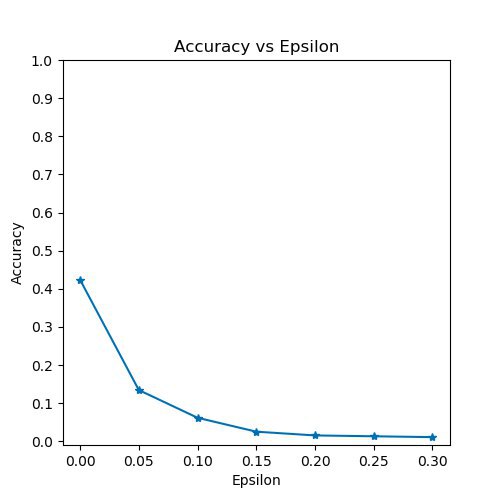@ptrblck, Hi!
I’m trying to visualize the adversarial images generated by this script:
https://pytorch.org/tutorials/beginner/fgsm_tutorial.html
This tutorial is used for the mnist data. Now I want to use for other data which is trained using the inception_v1 architecture, below is the gist for that one:
from __future__ import print_function
import torch
import torch.nn as nn
import torch.nn.functional as F
import torch.optim as optim
from torchvision import datasets, models, transforms
import numpy as np
import matplotlib.pyplot as plt
import os
epsilons = [0, .05, .1, .15, .2, .25, .3]
pretrained_model = "googlenet/googlenet_aux03_ep30.pth"
use_cuda=True
Net = models.googlenet()
#Even if set aux_logits to False, the state_dict throws the unexpected aux arguments.
num_ftrs = Net.aux2.fc2.in_features
Net.aux2.fc2 = nn.Linear(num_ftrs, 5)
num_ftrs = Net.fc.in_features
Net.fc = nn.Linear(num_ftrs, 5)
test_loader = torch.utils.data.DataLoader(
datasets.ImageFolder(os.path.join('data/val'), transform=transforms.Compose([
transforms.Resize(224),
transforms.RandomCrop(224),
transforms.ToTensor(),
transforms.Normalize([0.485, 0.456, 0.406], [0.229, 0.224, 0.225])
])),
batch_size=1, shuffle=True)
print("CUDA Available: ",torch.cuda.is_available())
device = torch.device("cuda:1" if (use_cuda and torch.cuda.is_available()) else "cpu")
model = Net.to(device)
model.load_state_dict(torch.load(pretrained_model, map_location='cpu'))
model.eval()
def fgsm_attack(image, epsilon, data_grad):
# Collect the element-wise sign of the data gradient
sign_data_grad = data_grad.sign()
# Create the perturbed image by adjusting each pixel of the input image
perturbed_image = image + epsilon*sign_data_grad
# Adding clipping to maintain [0,1] range
perturbed_image = torch.clamp(perturbed_image, 0, 1)
# Return the perturbed image
return perturbed_image
def test( model, device, test_loader, epsilon ):
# Accuracy counter
correct = 0
adv_examples = []
# Loop over all examples in test set
for data, target in test_loader:
# Send the data and label to the device
data, target = data.to(device), target.to(device)
# Set requires_grad attribute of tensor. Important for Attack
data.requires_grad = True
# Forward pass the data through the model
output = model(data)
init_pred = output.max(1, keepdim=True)[1] # get the index of the max log-probability
# If the initial prediction is wrong, dont bother attacking, just move on
if init_pred.item() != target.item():
continue
# Calculate the loss
loss = F.nll_loss(output, target)
# Zero all existing gradients
model.zero_grad()
# Calculate gradients of model in backward pass
loss.backward()
# Collect datagrad
data_grad = data.grad.data
# Call FGSM Attack
perturbed_data = fgsm_attack(data, epsilon, data_grad)
# Re-classify the perturbed image
output = model(perturbed_data)
# Check for success
final_pred = output.max(1, keepdim=True)[1] # get the index of the max log-probability
if final_pred.item() == target.item():
correct += 1
# Special case for saving 0 epsilon examples
if (epsilon == 0) and (len(adv_examples) < 5):
adv_ex = perturbed_data.squeeze().detach().cpu().numpy()
adv_examples.append( (init_pred.item(), final_pred.item(), adv_ex) )
else:
# Save some adv examples for visualization later
if len(adv_examples) < 5:
adv_ex = perturbed_data.squeeze().detach().cpu().numpy()
adv_examples.append( (init_pred.item(), final_pred.item(), adv_ex) )
# Calculate final accuracy for this epsilon
final_acc = correct/float(len(test_loader))
print("Epsilon: {}\tTest Accuracy = {} / {} = {}".format(epsilon, correct, len(test_loader), final_acc))
# Return the accuracy and an adversarial example
return final_acc, adv_examples
accuracies = []
examples = []
# Run test for each epsilon
for eps in epsilons:
acc, ex = test(model, device, test_loader, eps)
accuracies.append(acc)
examples.append(ex)
plt.figure(figsize=(5,5))
plt.plot(epsilons, accuracies, "*-")
plt.yticks(np.arange(0, 1.1, step=0.1))
plt.xticks(np.arange(0, .35, step=0.05))
plt.title("Accuracy vs Epsilon")
plt.xlabel("Epsilon")
plt.ylabel("Accuracy")
plt.show()
cnt = 0
plt.figure(figsize=(8,10))
for i in range(len(epsilons)):
for j in range(len(examples[i])):
cnt += 1
plt.subplot(len(epsilons),len(examples[0]),cnt)
plt.xticks([], [])
plt.yticks([], [])
if j == 0:
plt.ylabel("Eps: {}".format(epsilons[i]), fontsize=14)
orig,adv,ex = examples[i][j]
ex = ex.numpy().transpose((1, 2, 0))
mean = np.array([0.485, 0.456, 0.406])
std = np.array([0.229, 0.224, 0.225])
ex = std * ex + mean
ex = np.clip(ex, 0, 1)
#ex = ex.permute(1, 2, 0)
plt.title("{} -> {}".format(orig, adv))
plt.imshow(ex)
plt.tight_layout()
plt.show()
Upto the accuracy graph, the code ran well, but for the visualizing images it throws this error:
Traceback (most recent call last):
File "fgsm.py", line 156, in <module>
ex = ex.numpy().transpose((1, 2, 0))
AttributeError: 'numpy.ndarray' object has no attribute 'numpy'
any thoughts?


